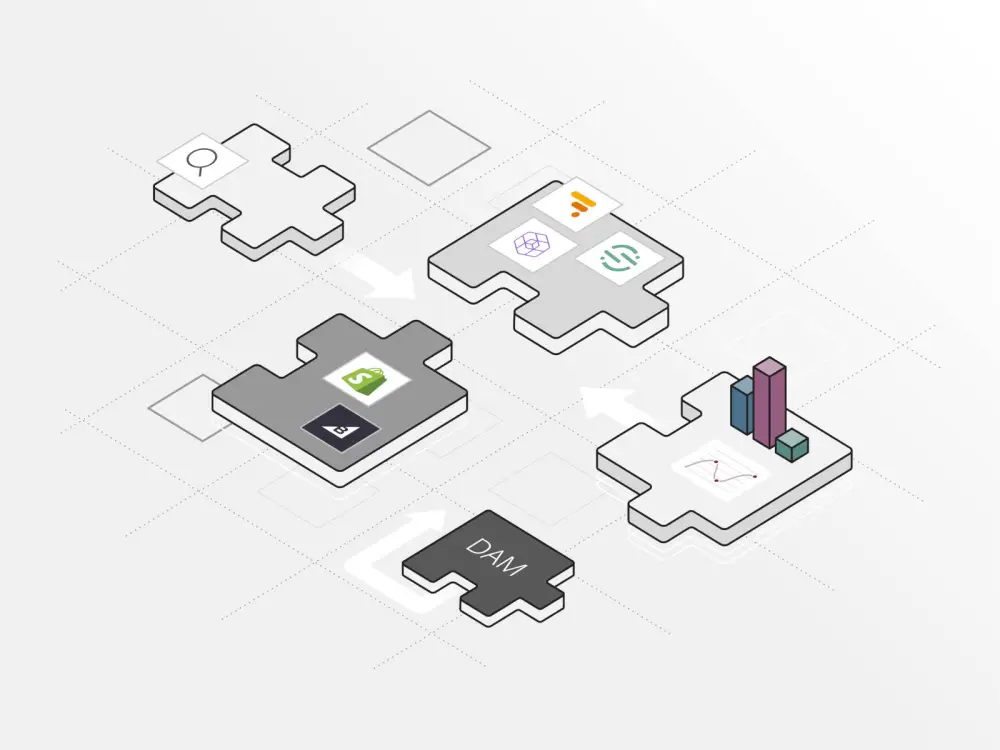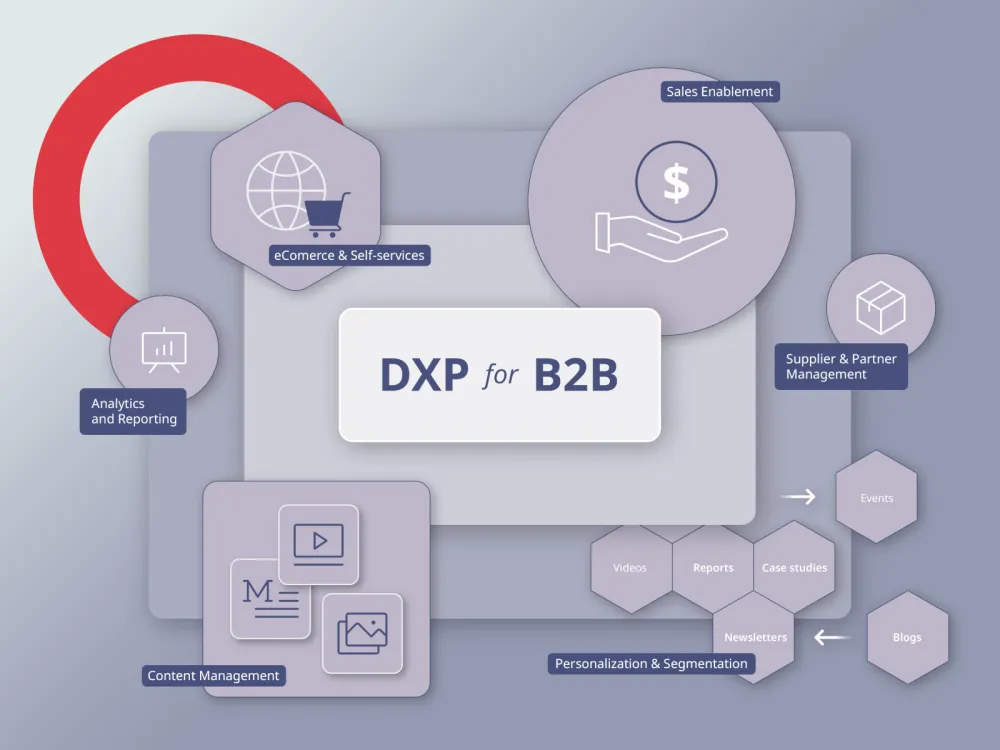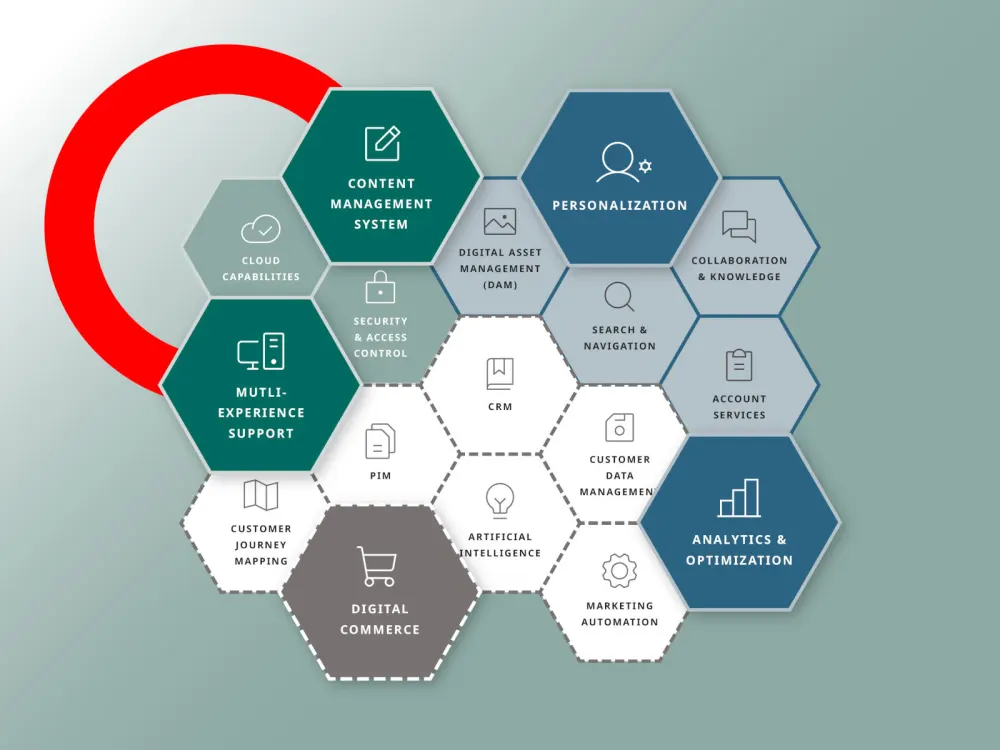Defining the DXP: A comprehensive approach
A digital experience platform (DXP) can be defined through a comprehensive approach that looks beyond just a toolset for managing content. It is an advanced software solution that enables businesses to build, deploy and continually improve websites, portals, mobile and other digital experiences. DXPs are primarily geared toward ensuring a smooth, personalized user journey, integrating multiple touchpoints and channels seamlessly.
DXPs are often a combination of several [concepts] such as CMS, analytics, personalization tools, and APIs. However, their primary role extends beyond content delivery to include understanding and enhancing customer interactions. This involves leveraging customer data, streamlining processes, and tailoring content to suit individual customer preferences.
It’s crucial to note that DXPs aim to provide a consistent, personalized experience regardless of the device or channel used by the customer. This approach ensures a holistic, high-quality digital experience that meets and exceeds customer expectations.
A Digital Experience Platform (DXP) is a suite of integrated technologies that facilitates the creation, management, and delivery of optimized digital experiences. Essentially, it’s a toolset designed to improve and unify all aspects of the customer journey. These tools work cohesively to ensure seamless user experiences across various digital touchpoints.
DXPs are not just about delivering content; they’re about understanding and enhancing the interactions between businesses and their customers. This includes personalizing content, streamlining processes, and leveraging customer data for improved business outcomes.
These platforms often consist of various elements such as CMS, analytics, personalization, and APIs, among others. The goal is to provide a consistent, personalized experience, no matter the channel or device the customer uses.
The evolution of management software
From traditional CMS to DXP
As the digital landscape evolved, the Traditional CMS which primarily dealt with content creation and management, started to feel limited. It lacked the ability to deliver personalized, cross-channel digital experiences. This spurred the growth of digital experience platforms (DXP), a more advanced solution that offers comprehensive capabilities beyond just content management. DXPs include components like analytics, personalization tools, and APIs, focusing on understanding and enhancing customer interactions. By leveraging customer data and streamlining processes, DXPs aim to deliver a consistent, personalized experience across various digital touchpoints. This shift from CMS to DXP represents a significant evolution in the approach to digital content delivery and customer engagement.
How technology influences the transition
Technology plays a pivotal role in driving the transition from CMS to DXP. First, the rise of Artificial Intelligence (AI) and Machine Learning (ML) has been instrumental in enabling DXPs to offer personalized content and experiences. These technologies analyze customer data to gain insights into user behavior, preferences, and needs, allowing businesses to tailor their content and offerings.
Second, the adoption of headless architecture has been crucial in the evolution. In a headless CMS, the content management and delivery aspects are decoupled, allowing for greater flexibility in content presentation across different platforms and devices.
Third, the shift towards microservices-based architectures has also influenced the transition. Microservices allow for the modular development and deployment of functionalities, which can be independently scaled and improved. This contrasts with the monolithic structure of traditional CMS, which can be rigid and slow to adapt to changes.
Finally, cloud computing has facilitated the scalability and accessibility of DXPs. It allows businesses to easily scale their operations up or down based on demand, and provide their services globally without major investments in infrastructure.
The role of analytics in modern content management
In the realm of modern content management, analytics play a pivotal role. Analytics is instrumental in assessing customer interactions, measuring performance, and identifying areas for improvement. It involves the systematic collection, measurement, and interpretation of data from various digital touchpoints. This data not only provides valuable insights into user behavior, engagement, and performance metrics but also helps identify friction points and sources of user frustration.
With the help of analytics, businesses can optimize content, personalize experiences, and make data-driven decisions to enhance customer journeys. For instance, by analyzing website traffic, session duration, bounce rates, and other behavioral data, businesses can gain valuable customer insights. These insights can then be used to make strategic adjustments to the content, design, and overall user experience of digital platforms.
In the context of a digital experience platform (DXP), analytics forms an integral part. It helps in tracking and improving digital experiences, enabling businesses to retain users, remain competitive, and drive growth. In essence, analytics is essential in building and delivering digital experiences tailored to the needs of the customers.
Key capabilities of a DXP
The key capabilities of a digital experience platform (DXP) revolve around enhancing user engagement and optimizing digital experiences.
- Personalization: DXPs leverage AI and ML technologies to offer personalized content and experiences based on user behavior and preferences.
- Integration: DXPs can integrate with various systems and technologies, facilitating seamless interactions across multiple channels and devices.
- Analytics: DXPs possess robust analytic capabilities, providing insights into user behavior and engagement, and enabling data-driven decision making.
- Scalability: With cloud computing, DXPs can easily scale operations to meet demand, ensuring efficient resource management.
- Security: Ensuring data protection and privacy is another key capability of DXPs, essential in the era of heightened cybersecurity threats.
These capabilities combined help businesses deliver a more cohesive and personalized user experience.
The benefits of adopting a DXP solution
Adopting a DXP solution comes with numerous benefits that can significantly enhance your digital presence. By leveraging a DXP, businesses can deliver personalized and contextualized experiences across various touchpoints, improving user engagement and satisfaction.
With DXPs’ robust analytics capabilities, businesses can gain valuable insights into user behavior and performance metrics, allowing them to make data-driven decisions and continuously optimize digital experiences.
Moreover, DXPs offer scalability through cloud computing, enabling businesses to efficiently manage resources and adjust operations based on demand.
An additional advantage is the integration capability of DXPs. They can seamlessly connect with various systems and technologies, facilitating smooth interactions across multiple channels and devices. This integration capability can help eliminate silos in organizations, resulting in more streamlined operations and better collaboration among teams.
Overall, adopting a DXP can lead to improved customer experience, increased user engagement, and ultimately, a higher return on investment.
Differentiating Between DXP and CMS
Features Comparison: DXP vs CMS
Let’s delve into the distinct features of both DXPs and CMSs.
A CMS primarily focuses on content creation, management, and delivery, primarily through a single channel such as a website. Key features include:
On the other hand, a DXP encompasses all CMS features while also offering advanced capabilities for engaging customers across various digital touchpoints. Essential features include:
- Omnichannel content delivery
- Personalization and segmentation
- Integration with third-party systems
- Real-time analytics and reporting
- AI and ML-driven insights
This comparison underscores the enhanced capabilities that make DXPs a more comprehensive solution for delivering personalized, cross-channel digital experiences.
When to choose DXP over CMS?
Choosing a DXP over a CMS is a strategic decision that often depends on your organization’s specific needs and objectives. A DXP might be a better fit if your organization is looking to:
- Deliver personalized experiences across multiple channels and touchpoints, including web, mobile, IoT devices, and more.
- Leverage robust analytics to gain deep insights into customer behavior and engagement.
- Scale operations and manage resources efficiently with cloud computing.
- Integrate seamlessly with various systems and technologies for a more cohesive digital ecosystem.
Remember, while a DXP offers more comprehensive functionalities, it also tends to be more complex and might require more resources to implement and manage. Carefully consider your organization’s capabilities and resources before making a choice.
User experience: DXP vs CMS
Delving into the realm of user experience, both DXPs and CMSs aim to deliver a pleasant and seamless digital journey. However, the way they approach this goal differs significantly. A CMS, with its focus primarily on content creation and management, provides a more linear and uniform user experience. This is mostly confined to single-channel interactions, typically a website. User experience within a CMS framework is largely centered around the content itself.
Contrastingly, a DXP takes a more holistic approach, providing a multichannel user experience that incorporates not only content but also various digital touchpoints. This leads to a more personalized and context-aware user experience. By combining different technologies such as AI and ML, DXPs can tailor the user experience based on individual preferences and behaviors, enhancing user engagement and satisfaction. Furthermore, the integration capability of DXPs allows for seamless interactions across multiple systems and devices, further enriching the user experience.
Best practices for implementing a DXP
Selecting the right DXP for your company
Identifying the right DXP for your company requires a careful evaluation of your specific needs, goals, and resources. First, identify your organization’s digital challenges and objectives. This will help you focus on the DXP features that are most relevant to your goals. Look for a platform that offers a low-code/no-code approach, allowing your team to independently set up campaigns and create landing pages.
Consider key features such as:
- Content management capabilities: These allow for effective organization and delivery of your digital content.
- Personalization technology: This ensures a tailored experience for each user, improving customer engagement and satisfaction.
- Omnichannel integration: This ensures a seamless customer experience across various digital touchpoints.
- Data analytics capabilities: These provide valuable insights into user behavior and performance metrics, enabling data-driven decision-making.
Also, consider the scale of your operations and budget, as the cost of a DXP will depend on the features required.
Integrating DXP tools with existing systems
Integrating DXP tools with your current systems is a critical step in maximizing its benefits and ensuring seamless operations. Integration provides a unified framework for the exchange of data and functionality between your DXP and other systems, enhancing cross-channel customer experiences.
The integration process should be tailored to your organization’s specific structure and needs. You might need to interact with a variety of systems, such as CRM, ERP, and e-commerce platforms.
Successful integration requires a strategic approach:
- Mapping out the integration points: Identify the systems you want to connect with your DXP.
- Establishing data flow: Define how data should flow between the systems.
- API usage: Using APIs for communication between systems can ensure seamless integration.
- Security: Ensure secure data transfer between systems.
Remember, a well-integrated system promotes operational efficiency and personalized user experiences.
Gartner’s Perspective on DXPs
Gartner, a renowned research and advisory firm, offers a unique perspective on digital experience platforms (DXPs). When Gartner retired its well-known Magic Quadrant for Web Content Management report in January 2020, the research firm noted that it saw client demand shifting from CMS technology “to the broader scope of DXP.” This is also evidenced by Gartner starting the Gartner Magic Quadrant for Digital Experience Platforms in 2020.
In its latest DXP report from February 2021, Gartner also says that DXPs now act as “centers of gravity” within organizations’ technology stacks to increase their digital presence. Gartner notes the impact of the growing DXP market, saying that, “application leaders in charge of digital experiences found themselves struggling with the usability, scalability and uptime of their DXP systems, given the spikes in traffic and growing demand for the digital channel.”
Further, the Australia-based publication CMO highlights that in 2020 the COVID-19 pandemic increased reliance on DXPs, as many organizations rushed “to set up digital commerce and experiences to meet changing consumer behaviors and needs.”
All of these insights point to the heightened need for greater flexibility and scalability as organizations increasingly find themselves under pressure to transform fast and remain nimble. DXPs have entered the spotlight as the solution to help businesses do just that.
List of top DXPs in the market today
In the pursuit of providing superior and personalized digital experiences, several DXPs have emerged as frontrunners in the market. These platforms have demonstrated robust capabilities, flexibility, and innovative features to meet evolving customer expectations. Some of the top players include:
- Adobe Experience Manager: Recognized for its comprehensive suite of tools focused on delivering seamless customer experiences across channels.
- Brightspot: Best in class publishing experience thats purpose built to integrate seamlessly into your ecosystem, connecting with everything from mobile apps to personalization engines.
- Siteglide: This DXP is designed to help digital agencies build and manage user-centric experiences such as online courses and customer portals.
- Acquia: Known for its unique blend of Drupal’s flexibility and Open Marketing Cloud platform, Acquia is a leader in creating unrivaled customer experiences.
- Wordpress VIP: An enterprise WordPress hosting solution with customer or digital experience features for enterprises.
- Bloomreach Commerce Experience Cloud: This platform personalizes the e-commerce experience, aiming to provide a unique shopping journey for each customer.
- Lumavate Digital Experience Platform: Among the popular choices, Lumavate offers a platform for creating and managing engaging digital experiences.
Remember, the right DXP for your organization will depend on your specific needs, objectives, and available resources.
Brightspot: A dynamic DXP in action
Most organizations won’t find a single-vendor solution for their DXP needs, so it’s critical to find a DXP that includes the support for custom and in-built integrations plus a flexible back-end framework to adapt to changing business needs and priorities.
Brightspot was designed to replace a traditional CMS. Brightspot was developed from years of our company providing the expertise and technology that some of the world’s largest organizations, including National Geographic, Walmart and Johnson & Johnson, use to deliver rich and responsive digital experiences.
Brightspot’s platform stands out because it’s built to integrate seamlessly into your ecosystem, connecting with everything from mobile apps to personalization engines.
On the technical side, Brightspot can unite various architectures, and then present the content in any way, on any channel. For example, a single data model on the back end can extend to seven different front-end delivery options that include headless, RSS and various JSON formats.
As such, the DXP provides a unified solution for building, deploying and managing the digital experiences your customers expect. Brightspot is extensible to your unique business needs, meaning zero compromise with the digital experience you want to deliver—not the other way around.
Brightspot also excels at providing the CMS pieces that still underpin a powerful DXP. Brightspot has offerings like flexible workflows, migration and replatforming tools, “create-once-and-publish-everywhere” modularity, and a publisher-informed editing interface and experience, which all combine to help drive the digital experience forward faster.
Digital experience platforms are now key to marketing technology stacks. They take the best elements of a CMS and add on to serve as a hub for delivering personalized omnichannel experiences.
As the DXP market grows increasingly crowded, Brightspot has developed its solution—Brightspot CMS—to be supremely flexible and integration-friendly so that organizations can attain innovative, modern content-marketing capabilities.
Future trends in digital experience platforms
As we look ahead, several trends are poised to shape the future of digital experience platforms (DXPs). Artificial Intelligence (AI) and Machine Learning (ML) will continue to play vital roles, especially in personalizing user experiences based on individual behaviors and preferences. Data privacy is another key focus, with increasing emphasis on collecting and protecting customer data.
Integration capabilities will further expand, allowing DXPs to seamlessly interact with various third-party solutions. This will enable businesses to create more comprehensive and tailored digital experiences.
Moreover, we anticipate a surge in the use of augmented and virtual reality (AR/VR) technologies in DXPs, offering more immersive and interactive experiences. These technologies, along with the Internet of Things (IoT) and edge computing, are expected to significantly influence the evolution of DXPs.
Lastly, the trend towards cloud-based solutions will continue to grow, providing businesses with flexible and scalable options to manage and deliver their digital experiences.









